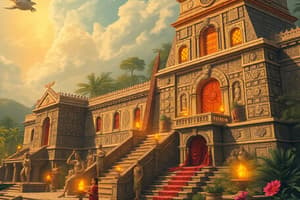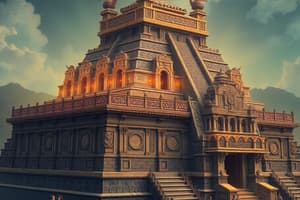Podcast
Questions and Answers
What was the primary claim about the Aztecs?
What was the primary claim about the Aztecs?
- The Aztecs thrived only in rare conditions.
- The Aztecs were unable to adapt to their environment.
- The Aztecs were able to overcome challenges in their environment. (correct)
- The Aztecs avoided environmental challenges entirely.
The Aztecs faced numerous challenges in their environment but could not overcome them.
The Aztecs faced numerous challenges in their environment but could not overcome them.
False (B)
What is a potential topic sentence that reflects the claim made about the Aztecs?
What is a potential topic sentence that reflects the claim made about the Aztecs?
The Aztecs demonstrated remarkable adaptability in overcoming environmental challenges.
The Aztecs were able to overcome ________ in their environment.
The Aztecs were able to overcome ________ in their environment.
Match the following Aztec challenges with how they overcame them:
Match the following Aztec challenges with how they overcame them:
The Aztec civilization primarily settled in __________.
The Aztec civilization primarily settled in __________.
The Inca civilization was predominantly located in __________.
The Inca civilization was predominantly located in __________.
The sole ruler of the Incas, known as _________________________, was believed to be part god.
The sole ruler of the Incas, known as _________________________, was believed to be part god.
Which civilization is known for creating floating gardens called chinampas?
Which civilization is known for creating floating gardens called chinampas?
Which ancient civilization spoke the language Nahuatl?
Which ancient civilization spoke the language Nahuatl?
The Inca civilization utilized similar agricultural techniques as the Aztecs.
The Inca civilization utilized similar agricultural techniques as the Aztecs.
Identify one way the Maya, Inca, and Aztecs were similar.
Identify one way the Maya, Inca, and Aztecs were similar.
Terracing refers to a system of roads built by the Inca.
Terracing refers to a system of roads built by the Inca.
What is one significant difference between the Inca civilization and the Maya and Aztec civilizations?
What is one significant difference between the Inca civilization and the Maya and Aztec civilizations?
What was the main purpose of a quipu in the Inca civilization?
What was the main purpose of a quipu in the Inca civilization?
What was the capital city of the Aztecs?
What was the capital city of the Aztecs?
Match the civilization with its primary geographical location:
Match the civilization with its primary geographical location:
The Aztec floating gardens were entirely above water, making harvesting easy.
The Aztec floating gardens were entirely above water, making harvesting easy.
The Maya settled in _______________________________, which today is known as part of Mexico and Central America.
The Maya settled in _______________________________, which today is known as part of Mexico and Central America.
Match the ancient civilization with their significant achievement:
Match the ancient civilization with their significant achievement:
The Inca worshiped Inti, who was known as the god of the night.
The Inca worshiped Inti, who was known as the god of the night.
Which of the following was the name given to the emperor in the Aztec empire?
Which of the following was the name given to the emperor in the Aztec empire?
What was the significance of the gorge in ancient civilizations?
What was the significance of the gorge in ancient civilizations?
Flashcards
Aztec environmental challenges
Aztec environmental challenges
The Aztecs were able to overcome challenges in their environment by developing innovative solutions to problems like limited resources, difficult terrain, and a challenging climate. They made use of the natural resources they had to their advantage and adapted their city planning and agricultural practices to succeed in their surroundings.
Chinampas
Chinampas
The Aztecs were able to overcome the challenge of limited resources by developing a complex agricultural system called chinampas. Chinampas were artificial islands created on shallow lakebeds, which allowed for increased agricultural productivity even on a limited land area.
Aztec irrigation
Aztec irrigation
The Aztecs adapted to the harsh environment by building a sophisticated irrigation system. They used canals, aqueducts, and reservoirs to manage water resources effectively. This enabled them to control water flow and ensure a reliable supply of water, crucial for their agricultural practices and city life.
Building with volcanic rock
Building with volcanic rock
Signup and view all the flashcards
Aztec environmental stewardship
Aztec environmental stewardship
Signup and view all the flashcards
Where did the Aztecs settle?
Where did the Aztecs settle?
Signup and view all the flashcards
Where did the Maya settle?
Where did the Maya settle?
Signup and view all the flashcards
Where did the Inca settle?
Where did the Inca settle?
Signup and view all the flashcards
What is a similarity between the Maya, Inca and Aztecs?
What is a similarity between the Maya, Inca and Aztecs?
Signup and view all the flashcards
How did the Inca civilization differ from the Maya and Aztecs?
How did the Inca civilization differ from the Maya and Aztecs?
Signup and view all the flashcards
What problem did the Aztecs face?
What problem did the Aztecs face?
Signup and view all the flashcards
How did the Aztecs overcome the problem of limited farmland?
How did the Aztecs overcome the problem of limited farmland?
Signup and view all the flashcards
How did the Aztecs overcome the challenge of harvesting crops from chinampas?
How did the Aztecs overcome the challenge of harvesting crops from chinampas?
Signup and view all the flashcards
Sapa Inca
Sapa Inca
Signup and view all the flashcards
Mesoamerica
Mesoamerica
Signup and view all the flashcards
Hieroglyphics
Hieroglyphics
Signup and view all the flashcards
Quipu
Quipu
Signup and view all the flashcards
Nahuatl
Nahuatl
Signup and view all the flashcards
City-states
City-states
Signup and view all the flashcards
Quetzalcoatl
Quetzalcoatl
Signup and view all the flashcards
Civilization
Civilization
Signup and view all the flashcards
Aqueduct
Aqueduct
Signup and view all the flashcards
Terracing
Terracing
Signup and view all the flashcards
Study Notes
Ancient Civilizations Test
- Inca Ruler: Sapa Inca, believed to be part god
- Maya Location: Mesoamerica, part of Mexico and Central America
- Maya Writing System: Hieroglyphics
- Inca Record Keeping: Quipu (a cord with knotted strings) for recording events and business transactions
- Aztec Language: Nahuatl
- Mayan City Structure: City-states, each with its own king
- Aztec Empire Structure: Set up their empire into each one having its own king
- Aztec Deity: Quetzalcoatl, the god of learning, wind, and life
- Complex Society Definition: A complex society has a developed language, religion, and government.
- Aztec Capital: Tenochtitlan, built on a lake; was the Aztecs capital city and built on a lake
- Mayan God: The Mayan god for fire and earth , as well as day and night is Itzamna
- Aztec People of the Sun: Known as the “People of the Sun
- Ancient Civilization Workers: In many ancient civilizations, commoners did most of the work
- Inca Road System: Built a large system of roads and bridges throughout their empire
- Inca Deity: Inti, known as god of the sun
- Aztec Emperor Title: Huey Tlatoani
- Civilization with Zero Concept: Aztecs were the first civilizations that developed the concept of zero
- Inca City: Machu Picchu, built high in the Andes for the king of the Incas
- Aqueduct Definition: A water conveyance system
- Pulley System Definition: Simple machine for lifting heavy objects
- Terracing Definition: Steps on the side of a mountain for farming
- City-State Definition (in this context): A city with its own government
- Gorge Definition (in this context): A narrow valley between hills or mountains
- Environment Definition (in this context): The surroundings in which a person lives
- Important Information About Aztecs, Chinampas: Aztec farmers developed floating gardens called chinampas to overcome challenges in their marshy environment
Studying That Suits You
Use AI to generate personalized quizzes and flashcards to suit your learning preferences.




